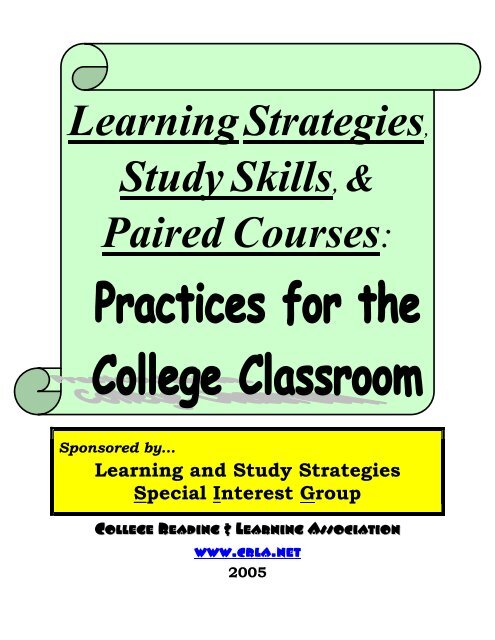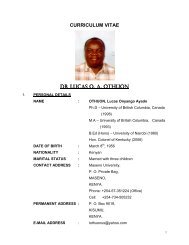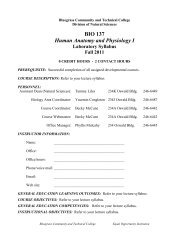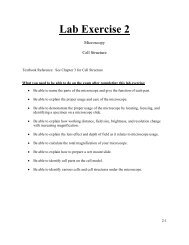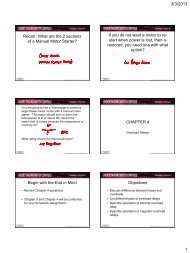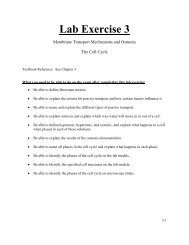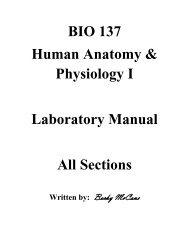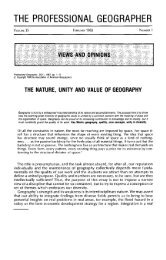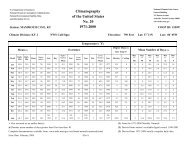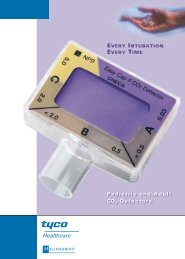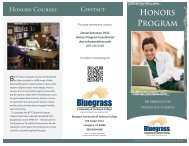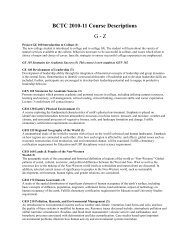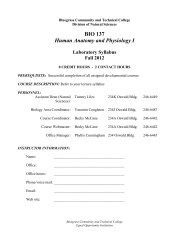Learning Strategies, Study Skills, & Paired Courses - College ...
Learning Strategies, Study Skills, & Paired Courses - College ...
Learning Strategies, Study Skills, & Paired Courses - College ...
You also want an ePaper? Increase the reach of your titles
YUMPU automatically turns print PDFs into web optimized ePapers that Google loves.
<strong>Learning</strong> <strong>Strategies</strong>,<br />
<strong>Study</strong> <strong>Skills</strong>, &<br />
<strong>Paired</strong> <strong>Courses</strong>:<br />
Sponsored by…<br />
<strong>Learning</strong> and <strong>Study</strong> <strong>Strategies</strong><br />
Special Interest Group<br />
<strong>College</strong> Reading & <strong>Learning</strong> Association<br />
www.crla.net<br />
2005
<strong>Learning</strong> <strong>Strategies</strong>, <strong>Study</strong> <strong>Skills</strong>, & <strong>Paired</strong> <strong>Courses</strong><br />
Practices for the <strong>College</strong> Classroom<br />
CONTENT<br />
GENERAL LEARNING STRATEGIES<br />
PAGE STRATEGIC LEARNING IN THE COLLEGE CLASSROOM<br />
2. Sharing Weekly Goals & Progress. Arden B. Hamer, Indiana University of Pennsylvania<br />
3. Collaborative Posters for Strategic <strong>Learning</strong>. Arden B. Hamer, Indiana University of PA<br />
4. Students’ Letters to Themselves. Jean Leiner, Niagara University, NY<br />
MOTIVATION<br />
6. Ideal Collage. Jane V. Tichenor, Ivy Tech State <strong>College</strong>, IN<br />
7. Using Games & Visual Aids to Enhance <strong>Learning</strong>. Ruth A. Doucette, University of Maine<br />
LISTENING & NOTE TAKING STRATEGIES<br />
10. The Importance of Note Taking. Virginia D. Granda, University of Texas at El Paso, TX<br />
11. Using Mock Lectures. Sheilagh Grills, Brandon University, Manitoba, Canada<br />
READING & STUDY STRATEGIES<br />
14. Using Textbook Features. Julia Bickel, Indiana Wesleyan University, IN<br />
15. It Works for Me: A Recommended Software Program. Susanne Manovill, University of<br />
Prince Edward Island, Canada<br />
16. Using Think Aloud’s. Jane McGrath, Paradise Valley Community <strong>College</strong>, AZ<br />
17. PAR for the Course: A Technique for Reading and <strong>Study</strong>ing. Edith Miller, East<br />
Stroudsburg University of Pennsylvania, PA<br />
18. Effective <strong>Study</strong> Cards. Linda Russell, Minneapolis Community/Technical <strong>College</strong>, MN<br />
19. Improving Memory when Reading <strong>College</strong> Texts. Diane Van Blerkom, University of<br />
Pittsburgh at Johnstown, PA<br />
20. Reading with Purpose. Elaine Wright, University of Southern Maine, ME<br />
21. Tips for Reading <strong>College</strong> Texts. Elaine Wright, University of Southern Maine, ME<br />
WRITING STRATEGIES<br />
24. A Peer-Editing Writing Workshop. Frieda R. Campbell-Peltier, Portland Community<br />
<strong>College</strong>, OR<br />
25. Writing without Errors. Ray M. Sanchez, California State University, Fresno, CA<br />
26. Writer’s Self-Assessment Survey. Cecilia Torres Best, Chaffey <strong>College</strong>, CA<br />
i
LINKING STRATEGIES<br />
PAGE LEARNING STRATEGIES & MATHEMATIC COURSES<br />
28. <strong>Learning</strong> and Critical Thinking <strong>Strategies</strong> in Mathematics. Paola Di Muro, Brandon<br />
University, Canada<br />
29. Reading Math Problems. Jean LaBauve, Spokane Falls Community <strong>College</strong>, WA<br />
30. Math <strong>Study</strong> Tips. Marsha Urban & Sean Rivers, University of Nevada, Reno<br />
31. Concept Mapping and Reading Math Texts. Rudy Gunawan & Jean LaBauve, Spokane<br />
Falls Community <strong>College</strong>, WA<br />
LEARNING STRATEGIES & SOCIAL SCIENCE COURSES<br />
34. A Structured <strong>Learning</strong> Strategy Model to Guide Reading. Ruth A. Britton, Cochise<br />
<strong>College</strong>, AZ<br />
35. Textbook Marking for More Effective <strong>Study</strong>ing. Sharon Green, Niagara University, NY<br />
36. Developing Listening and Note Taking <strong>Skills</strong>. Sharon Green, Niagara University, NY<br />
37. Using Technology for Critical Reading of Linked Course Content. Gretchen Starks-<br />
Martin, St. Cloud State University, MN<br />
STRATEGIES FOR SUCCESSFUL LEARNING COMMUNITIES<br />
39. Two-Stage Testing Process. Shawn Bixler, University of Akron, OH<br />
40. Recognizing Behaviors of At-Risk Students. Maggi Miller, <strong>College</strong> Survival and Faculty<br />
Programs, Houghton Mifflin Co.<br />
41. Supplemental Instruction and <strong>Paired</strong> <strong>Courses</strong>. Gladys R. Shaw, University of Texas at<br />
El Paso, TX<br />
ii
FORWARD<br />
Sally Lipsky, editor<br />
At the CRLA annual conference in October 2003, at Albuquerque, NM, colleagues interested<br />
in joining the newly-formed <strong>Learning</strong> & <strong>Study</strong> <strong>Strategies</strong> SIG gathered for the first time. At this<br />
meeting members completed a survey about potential topics and activities that they wanted to<br />
focus on within this new SIG. Respondents overwhelming indicated that their top priority was<br />
the sharing of effective programs and practices. Thus, the handbook, <strong>Learning</strong> <strong>Strategies</strong>, <strong>Study</strong><br />
<strong>Skills</strong>, & <strong>Paired</strong> <strong>Courses</strong>: Practices for the <strong>College</strong> Classroom, was born as a means for sharing<br />
useful instructional practices related to college learning and study strategies.<br />
Contributions were solicited from among all CRLA members. Twenty-seven (27) people<br />
responded with their contributions of especially successful, unique, and/or rewarding<br />
instructional practices.<br />
I expect that you will enjoy reading and trying out colleagues’ suggestions as much as I have!<br />
~ Sally Lipsky, chairperson, <strong>Learning</strong> & <strong>Study</strong> <strong>Strategies</strong> SIG (sal@iup.edu)<br />
Indiana University of Pennsylvania<br />
October 2005<br />
iii
General <strong>Learning</strong> <strong>Strategies</strong>:<br />
Strategic <strong>Learning</strong><br />
in the Classroom<br />
1.
Sharing Weekly Goals and Progress<br />
Description<br />
For weekly goals to be more meaningful, students should do more than just reflect about what<br />
they intend to do. Instead, direct students to write their weekly goal in their planner at the end of<br />
each class session. Then, ask each student to tell their goal to classmates. At the beginning of the<br />
next class session, have students, one at a time, report their progress toward reaching their goal.<br />
If a student does not reach their goal, do a brief problem-solving session to help the student<br />
develop additional strategies.<br />
Additional Recommendations<br />
It is acceptable for students to work on the same goal week after week. Sometimes I set my own<br />
weekly goal and then tell the students why I did or did not achieve the goal. If I did not, I declare<br />
the same goal for the next week. Students have enjoyed asking me about my progress and<br />
struggles, which has helped them to see that success does not happen instantly!<br />
Contributor<br />
Arden B. Hamer, Reading/<strong>Study</strong> <strong>Strategies</strong> Specialist & Educational Advisor, Indiana<br />
University of Pennsylvania, PA (ahamer@iup.edu)<br />
2.
Collaborative Posters for Strategic <strong>Learning</strong><br />
Description<br />
Students need time to pause and reflect in order to consciously and successfully transfer<br />
strategies to the next learning experience. In addition, student learning is enhanced in a<br />
collaborative experience where they can read and hear what their peers are doing.<br />
As a wrap-up to a semester-long study strategy course, students create a set of collaborative<br />
posters. At the top of each poster is a different starter quote:<br />
• I would advise a new freshman to…<br />
• My greatest academic accomplishment this semester was…<br />
• Next semester I will…<br />
• My favorite learning strategy is…<br />
Students travel around the room to each poster, read what other students have written, and then<br />
write their own responses along with their initials.<br />
Additional Recommendations<br />
The completed posters are very beneficial for new freshmen who do not know what to expect<br />
from their college classes. The posters provide great discussion starters and make instruction in<br />
learning strategies more meaningful to students enrolled in future First-Year Experience courses.<br />
Contributor<br />
Arden B. Hamer, Reading/<strong>Study</strong> <strong>Strategies</strong> Specialist & Educational Advisor, Indiana<br />
University of Pennsylvania, PA (ahamer@iup.edu)<br />
3.
Students’ Letters to Themselves<br />
Description<br />
At the end of fall semester, I give students sheets of stationery and envelopes. Each student<br />
writes a letter explaining “three things I learned during my first semester at college.” The<br />
following August, I mail students their self-addressed, sealed envelopes prior to the start of their<br />
sophomore year. Many students drop by my office to comment on what they wrote to<br />
themselves!<br />
Additional Recommendation<br />
Keep the letters confidential. Do not read them!<br />
Contributor<br />
Jean Leiner, Reading Specialist, Niagara University, NY (jleiner@niagara.edu)<br />
4.
General <strong>Learning</strong> <strong>Strategies</strong>:<br />
Motivation<br />
5.
Ideal Collage<br />
"All our dreams can come true--if we have the courage to pursue them." Walt Disney<br />
Description<br />
This assignment, the Ideal <strong>College</strong>, helps students to think about their positive qualities, areas for<br />
improvement, and future goals. Students begin to think about their lives as they are now and how<br />
they want them to be in the future. They set time frames for achieving short-term goals which,<br />
ultimately, lead to achieving long-term goals. Also, the assignment sets the stage for career<br />
planning, which is introduced the last half of the semester. Furthermore, it teaches responsibility<br />
to meet deadlines and to avoid procrastination.<br />
1. Distribute the assignment sheet and explain that the students are to brainstorm on their<br />
positive qualities, areas for improvement, and goals.<br />
2. Explain how to construct the collage – the front of the poster board is to represent them<br />
as they are now, and the back is to represent them as they would like to be in the future.<br />
Students can use photographs, pictures from magazines and newspapers, words,<br />
drawings, memorabilia, and so on.<br />
3. Do not grade on artistic ability. Instead, determine grades by content of the pre-activities,<br />
the poster, and the presentation.<br />
4. For the presentation, direct one student to hold the poster for the person presenting.<br />
(Having someone else standing beside the presenter helps to calm fears.) The person<br />
holding the poster will present next while a new volunteer holds the poster. Continue<br />
until all students have presented. After they present, the students place their posters<br />
around the room.<br />
5. Afterwards, students write positive comments to other students about their presentations<br />
(that is, words of encouragement or things they can relate to) on index cards. Allow 10<br />
minutes for them to write their comments; then have them place the cards under the<br />
posters. Students gather their cards and read the comments.<br />
Contributor<br />
Jane V. Tichenor, Ivy Tech State <strong>College</strong>, Evansville, IN (jticheno@ivytech.edu)<br />
6.
Using Games and Visual Aids to Enhance <strong>Learning</strong><br />
Description<br />
Students need the opportunity to work with and manipulate course content. Silently reading text<br />
material, listening to lectures, and taking notes (passive learning) isn’t enough for students<br />
(especially first-year students) to adequately understand, process, and apply information. Peer<br />
tutors (or instructors) can use games, activities and visual aids to help “bring course material to<br />
life”; allowing students to actively participate and engage in what they learn by using all<br />
modalities. As we all have learned from brain science workshops, the more guided practice one<br />
has, the richer the neural networks become to remember and apply information learned.<br />
At “The Tutor Program,” University of Maine, we developed a game resource file for tutors,<br />
including a resource chest filled with craft materials for use in creating games: dice, game pieces,<br />
timers, toothpicks, Styrofoam balls, pipe cleaners, wire, beads, cards, molecular model kits, silly<br />
putty, clay, colored pencils, crayons, and lego’s. It truly is amazing what tutors can do with a<br />
little creativity and imagination! For example:<br />
• Biology tutors use magnetic, molecular model kits so students can build RNA, DNA, double<br />
helixes and more. Through creating their own model, students’ learning is far greater than by<br />
just studying a detailed graph.<br />
• Chemistry tutors play “Go Fish” to demonstrate bonding elements and develop “Singles<br />
Ads” to highlight attracting molecules.<br />
• Math and Physics tutors play Jeopardy, Pictionary, and Bingo to work on like concepts and<br />
problems in a different medium.<br />
In preparation for finals, tutors frequently assign each of their students the task of coming up<br />
with a game, activity, or visual aid to demonstrate a particular section of the course to the rest of<br />
the group. The more the students are involved in the creation of the activity, the greater the<br />
learning. For instance, students can be assigned to develop note cards on a concept, sections<br />
from their text, or their notes. These note cards then can be used in the preparation of a memory<br />
type game, such as “Outburst,” “Taboo,” “Go Fish,” or “Clue”. These activities can be adapted<br />
to a variety of subjects. And students have fun while learning!<br />
Training peer tutors regarding the benefits of active learning versus simply re-teaching course<br />
material or doing more problems is the key to the success of these games. If tutors do not buy<br />
into active learning, their reserve manner and attitude will trickle down to the students in their<br />
groups. All of our tutor training sessions include activities which demonstrate active learning.<br />
Listed below are a few games that tutors have used in group tutoring sessions:<br />
JEOPARDY: An excellent vehicle to practice vocabulary, definitions, theories, math formula,<br />
equations, graphs, processes and concepts. Also, this game provides an opportunity for students<br />
to learn how to develop potential test questions and prepare for exams. Use the same format as<br />
the TV game show.<br />
7.
Using Games & Visual Aids to Enhance <strong>Learning</strong> (cont’d.) 8.<br />
BINGO: Each square contains a vocabulary word, picture, graph, math formula, or equation.<br />
Each student’s card should be arranged in a slightly different order. As the tutor reads from note<br />
cards that students prepared, the students try to find a match on their card. If a match is found,<br />
the student has to explain why it is a match. If other students feel that there is not a true match,<br />
they can challenge and explain why.<br />
OUTBURST: Another game which encourages group interaction. Students write a vocabulary<br />
word, process, graph, event, date, theory, or formula on index cards. On the back of the card are<br />
several items associated with that word. The object is for the students to try to guess as many of<br />
the related items as possible within a time limit.<br />
GO FISH: Using index cards, students write down a vocabulary word, process, graph, theory, or<br />
equation. Then shuffle the deck and deal five cards out to each player. The remainder of the pile<br />
goes in the middle. Players take turns and ask for a match by describing the process, graph,<br />
formula, theory or definition. If there is no match, the student must “Go Fish” by drawing<br />
another card out of the middle deck. The point of the game is to match all of your cards. The<br />
winner has to describe why each pair is a match.<br />
TABOO: This is similar to Outburst. At the top of a note card is a vocabulary word, process,<br />
theory, or formula and on the bottom are a list of words that may not be said while trying to<br />
describe the concept to the other students. One student holds a card and tries to get the other<br />
students to guess what the word, theory, or formula is without using any of the words at the<br />
bottom of the card. This helps students to go beyond the text definition and develop concepts in<br />
their own words.<br />
Additional Recommendations<br />
There are many more game shows on TV and board games with which students are familiar.<br />
Language tutors can use scrabble and games used in the culture of the language with which they<br />
work. Tutors can adapt football, baseball and basketball (not actually on the court or field) to<br />
learning concepts. It just involves a little ingenuity, creativity and believing that we can still<br />
learn through play, no matter how old we are!<br />
Contributor<br />
Ruth A. Doucette, Tutor Coordinator, The Tutor Program, University of Maine, ME<br />
(Ruth_A._Doucette@umit.maine.edu)
General <strong>Learning</strong> <strong>Strategies</strong>:<br />
Listening & Note Taking<br />
<strong>Strategies</strong><br />
9.
The Importance of Note Taking<br />
Description<br />
This activity increases students’ awareness of the importance of listening and note taking.<br />
Students listen to a mini lecture (about 15 minutes) and take notes. Students then trade notes with<br />
a classmate and take a quiz using these notes.<br />
Students are graded on two factors: 1) The grade they make on the quiz; and 2) The grade<br />
another student gives to their notes. Students realize that a good grade depends heavily on the<br />
notes they take.<br />
“The Importance of Note Taking”<br />
1) Listen to the lecture and take notes. At the end of the lecture you will be given a<br />
quiz with open notes.<br />
2) Exchange notes with a classmate.<br />
3) Answer the quiz using your classmate’s notes.<br />
4) Give a letter grade to the notes you received from your classmate.<br />
Additional Recommendations<br />
Include the classmate’s grade as part of each student’s quiz grade. Also, direct students to give a<br />
specific grade (AF) to the other person’s notes. In order to avoid biased grades, do this activity<br />
mid-semester after you become aware of existing friendships within the classroom.<br />
Contributor<br />
Virginia D. Granda, CircLES/ESP Coordinator, University of Texas at El Paso, TX<br />
(granda@utep.edu)<br />
10.
Using Mock Lectures<br />
Description<br />
Students practice active listening for three different lecturing styles. As students take notes, they<br />
pay particular attention to the lecturer’s verbal and non-verbal cues. The instructor uses varying<br />
styles when delivering the lecture on the topic of note taking strategies:<br />
♦ The Pacer – The lecturer is active physically, but with a monotone vocal presentation.<br />
The lecturer uses an overhead to present headings for content.<br />
♦ The Reader – The lecturer is physically static, with a quick-paced reading of essential<br />
lecture material in an organized list format.<br />
♦ The Talker – The lecturer uses a conversational style of delivery with questions directed<br />
at students. There are some physical movements, with brief notes written on the board.<br />
After the mini-lectures, students compare their notes with complete notes presented in various<br />
forms (e.g. standard outline, concept map, Cornell method). The class has a lively discussion of<br />
the differences between their immediate comprehension of the mini-lecture and the quality of<br />
their notes, as well as the pros and cons of each lecture style.<br />
This exercise allows the students to more easily separate lecture content from lecture delivery.<br />
Students are encouraged to look for the learning opportunity in a lecture, and to take ownership<br />
for their role as an active listener rather than a passive consumer.<br />
Additional Recommendations<br />
The exercise is readily adaptable to fit various note forms and lecture styles in science- or<br />
humanity-oriented courses. Two mini-lectures may fit better in a 50-minute class time. This<br />
exercise flows nicely from a discussion of learning styles. It provides an emphasis on personal<br />
responsibility.<br />
Contributor<br />
Sheilagh Grills, <strong>Learning</strong> <strong>Skills</strong> Specialist, Brandon University, Brandon, Manitoba<br />
(grillssh@brandonu.ca)<br />
11.
12.
General <strong>Learning</strong> <strong>Strategies</strong>:<br />
Reading & <strong>Study</strong><br />
<strong>Strategies</strong><br />
13.
Using Textbook Features<br />
Description<br />
Struggling students often do not think about or utilize various study aids. This activity helps<br />
students realize that textbooks have many features that they can use to their advantage when<br />
reading, studying, and preparing for tests.<br />
Assign each student a textbook feature. Students prepare a short presentation about their assigned<br />
feature for which they identify and describe the feature, its function, and how it is useful for<br />
college students. Students can use PowerPoint, art work, props, drama, or other means to present<br />
their 3-minute presentation. Also, they identify an example of that feature in our textbook, as<br />
well as an example from another text.<br />
Additional Recommendations<br />
Don’t let students’ lack of interest stop you from implementing this project. Some students will<br />
say that they already know all of the information. However, with encouragement to be creative in<br />
their presentations, students enjoy viewing each other’s creativity and talents. As one noted, “I<br />
learned more about textbook features than I thought I ever wanted to know!” A few marked this<br />
activity as a highlight on the end of course evaluation.<br />
Features include: prefaces, tables of contents, section introductions, chapter outlines, chapter<br />
objectives, lists and sequences, sidebars or boxes, tables, graphic aids, vocabulary aids, study<br />
questions and activities, chapter summaries, appendices, bibliographies, suggested readings,<br />
webliographies, and indexes.<br />
A wonderful source for a list, description, and example of many textbook features is the text<br />
Opening Doors: Understanding <strong>College</strong> Reading, 4th ed., by J. Cortina and J. Elder. Also,<br />
various study skills websites have this information.<br />
Contributor<br />
Julia Bickel, Associate Professor of English & Reading, Indiana Wesleyan University, IN<br />
(Julia.Bickel@indwes.edu)<br />
14.
It Works for Me: A Recommended Software Program<br />
Description<br />
Having taught the Effective Reading course at the University of Prince Edward Island for the<br />
past 34 years, I’ve found that the Quantum Reading Series, published by Steck-Vaughn Co., to<br />
be an ideal instrument to prepare the groundwork for developing better study techniques for<br />
students. The software includes key vocabulary for each lesson and pre-reading cloze exercises.<br />
The software also includes a comprehension test which presents results in percent format.<br />
In two study technique lectures scheduled for mid-course, I instruct students how to utilize their<br />
newly acquired software skills in their university studies. This transfer of knowledge involves<br />
students using enhanced preview, study and review techniques.<br />
After a six-week course, students have doubled or even tripled their skimming and reading<br />
speeds and have considerably increased their comprehension. Many students claim that this<br />
course has assisted them tremendously in their acquisition and absorption of new knowledge.<br />
Additional Recommendation<br />
I have developed additional exercises to enable students to raise their skimming and reading<br />
speeds. Contact me if you are interested in the supplementary material that I created.<br />
Contributor<br />
Susanne Manovill, Instructor, Effective Reading Program, University of Prince Edward<br />
Island, Canada (manovill@upei.ca)<br />
15.
Using Think Alouds<br />
Description<br />
All too often a student believes that “everyone but me” can pick up any printed information, read<br />
it straight through, and understand it completely. To dispel this perception, I often use “think<br />
alouds” that model how I make sense of text.<br />
I ask students to bring in a newsletter or magazine about a hobby or a content textbook. I<br />
randomly select a student’s material and ask the student to identify a portion for me to read.<br />
Seated in front of the class, I begin to “read aloud.” I might, for example, start with previewing<br />
the selection and setting a purpose for my reading. As I read, I might pause to ask myself a<br />
question about the gist of what I am reading or even about individual words and phrases. I try to<br />
consciously draw upon background knowledge and refer to other things I might have read or<br />
heard about the topic. When something is particularly difficult to understand—and there is<br />
almost always something difficult—I stop and describe some of my options. When I complete<br />
the selection, I decide if I’ve fulfilled my purpose for reading. And, if I haven’t, I talk about what<br />
I should do next.<br />
By verbalizing my reading process on different types of materials, students see that most readers<br />
have to work at reading and that the amount of work depends on the material. This process gives<br />
students permission to not understand what they read the first time and gives them strategies for<br />
reading purposefully and productively.<br />
Additional Resources<br />
Salinger, Terry. (2003). “Helping Older, Struggling Readers,” Preventing School Failure, 48, 79-<br />
85.<br />
Pressley, M., & Afflerbach, P. (1995). Verbal Protocols of Reading: The Nature of<br />
Constructively Responsive Reading. Hillsdale, NJ: Erlbaum.<br />
Contributor<br />
Jane McGrath, Professor Emerita, Paradise Valley Community <strong>College</strong>, AZ (Jellenjay@aol.com)<br />
16.
PAR for the Course: A Technique for Reading and <strong>Study</strong>ing<br />
Description<br />
Frequently students are familiar with textbook strategies such as SQ3R or PQ3R but fail to apply<br />
them to their content materials because they feel these techniques are too time-consuming. “PAR<br />
for the Course” shortens the process while still maintaining essential elements.<br />
“PAR for the Course”<br />
1. Prepare – Read the title and introduction to the chapter. Think about any knowledge or<br />
experience you have with this topic. Turn to the back of the chapter and read the<br />
summary and any study questions.<br />
2. Activate your mind – Break the chapter into “chunks” based on the headings or<br />
subheadings. Read each section actively by focusing on and thinking about what you are<br />
reading.<br />
3. Remember – After you’ve read each section, stop, look away from the book, and<br />
remember the important points. Take notes. Then continue reading another section. Also,<br />
when you reach a point that you don’t remember what you have just read, stop reading<br />
and take a break. When you return, begin with that section and continue until you are<br />
finished the chapter or need another break.<br />
Additional Recommendation<br />
Instructors may wish to emphasize the efficiency of the technique. This helps students monitor<br />
their reading and gives them permission to take breaks when needed, rather then wasting time<br />
staring at the page.<br />
Contributor<br />
Edith F. Miller, Professor/Director of Disability Services, East Stroudsburg University of<br />
Pennsylvania (emiller@po-box.esu.edu)<br />
17.
Effective <strong>Study</strong> Cards<br />
Description<br />
This activity encourages students to make effective study cards. Students choose new and<br />
important terms or concepts and make study cards by answering questions (see section below).<br />
Not all questions have answers; however, this method moves students beyond simple<br />
memorizing. At first, students tend to be fairly mechanical about answering the questions, but<br />
later they begin to anticipate which questions will be most meaningful. When they take tests,<br />
students realize they are better prepared for higher level questions. This works well with paired<br />
courses because the students have immediate needs for studying new terms.<br />
Format of study cards:<br />
FRONT: the term, principle, or concept<br />
→ spelled correctly<br />
→ pronunciation given, if necessary<br />
→ coded to the chapter and page of the text<br />
BACK:<br />
1. What is the definition in your own words?<br />
2. What is an example? (From the book, lecture, or your own – but it has to be right!)<br />
3. How does it work (if it is a process)?<br />
4. What does it do?<br />
5. What effect does it have on other things (terms, concepts)?<br />
6. What is it a part of?<br />
7. What is part of it?<br />
8. What is it related to?<br />
9. What is it distinguished from (what isn’t it)?<br />
10. What is a drawing, chart, mnemonic device, or other method you will use to help you<br />
remember it?<br />
Additional Recommendations<br />
Collect cards for each chapter for points. After a test, point out various test questions that could<br />
have been answered by a study card. Also, acknowledge that making study cards in this format<br />
takes time, but is a good investment of time when learning the information.<br />
This generic format can be modified to better fit particular subjects. However, the idea is the<br />
same – go beyond the definition!<br />
Contributor<br />
Linda Russell, <strong>Learning</strong> Center Coordinator, Minneapolis Community and Technical <strong>College</strong>,<br />
Minneapolis, MN (Linda.Russell@minneapolis.edu)<br />
18.
Improving Memory when Reading <strong>College</strong> Texts<br />
Description<br />
Many students read their textbooks but don’t remember much of what they’ve read. The<br />
following memory strategy has been successful with students who want to improve their memory<br />
when reading text material.<br />
Direct students to read one page of a textbook and then close the book.<br />
Then, instruct students to write down everything they can recall on a piece of paper. I tell<br />
them to write in blue ink (for example) putting information that they recall from the top of<br />
the text page in the top 1/3 of the paper and information that was somewhere in the middle of<br />
the text page in the middle to the paper and information that was near the bottom of the text<br />
page in the bottom 1/3 of the paper.<br />
Next, direct students to open the text to that same page and reread the page filling in any<br />
missing information using a red (or different colored) pen or pencil. Explain that they should<br />
practice this strategy daily using a new page of text that they haven’t read before. Repeat this<br />
process in class a few times just to be sure they are doing it correctly. For example, students<br />
are not expected to recall the text material word for word, but instead to remember and write<br />
important pieces of information using meaningful phrases.<br />
Day-by-day students should see more blue ink than red ink written on their paper. After a<br />
week or two, they should be able to recall all of the important information from one page of<br />
text quite well.<br />
Finally, direct students to do the activity with two pages and two pieces of paper on which to<br />
write what they recall and then fill in what they missed. Again, they should see that they are<br />
able to recall more of the information each day. Some students continue to practice and work<br />
on recalling three, four, or even five pages of text material. The number of pages will vary<br />
depending on the level of detail in the text (for example, biology will probably be more<br />
difficult to recall than sociology).<br />
This method is effective in building memory because: 1) students develop new strategies to<br />
improve their memory of the material, and 2) students get immediate feedback on how well they<br />
are doing. Students have reported that they pay more attention when they read, mentally rehearse<br />
the information before closing the text, or even spend more time identifying main ideas and<br />
supporting details. It doesn’t really matter how they improve their memory of the material, the<br />
key is that they find a way to do it.<br />
Additional Recommendation<br />
For some students this activity is easier to do on the computer since they won’t have to space out<br />
the information that they initially recall. Instead, students can move the cursor to a spot where<br />
they want to fill in information and use a different font or color to do so.<br />
Contributor<br />
Diane Van Blerkom, Assistant Professor, Academic Support Center, University of<br />
Pittsburgh at Johnstown, PA (dvanbler+@pitt.edu)<br />
19.
Reading with Purpose<br />
Description<br />
Students often attack college reading assignments by simply starting on the first page and<br />
passively reading, which usually results in poor reading comprehension. Remind students that<br />
highlighters are actually reading tools (as opposed to “study tools”), that are useful for<br />
maintaining focus.<br />
The most important advice is to tell students to always read with purpose. This means to read in<br />
quest of answering questions. Students can look for questions in text chapters or class lecture<br />
notes. Often students need to create their own questions from chapter headings and sub-headings.<br />
In any case, reading with purpose, with criteria, is essential.<br />
SUPPORT ACTIVITY<br />
To impress the point of reading with purpose, divide your class in half.<br />
• Direct ‘Half A’ to walk to a designated place and back again, observing their surroundings.<br />
• Direct ‘Half B’ to do likewise, but give them 3-4 questions you will be asking when they<br />
return.<br />
• When the class reassembles, quiz everyone on the 3-4 questions. For example: How many<br />
windows did you pass? What departments are in this hallway? How many restrooms did you<br />
see? What colors are the floor and wall?<br />
• ‘Half B’ will get the answers correct, while ‘Half A’ will struggle.<br />
• Now, ask another 3 new questions to the whole class.<br />
• Once again, ‘Half B’ will score much better….even though they had no prior knowledge of<br />
these questions!<br />
THE STRATEGY<br />
When reading with purpose, we not only remember the answers to pre-questions, but we better<br />
remember the material not meeting the answer criteria because we are reading with a very<br />
specific purpose. When we read with purpose, we are actually “processing” information (that is,<br />
thinking about it) as we mentally compare what is being read to the criteria of the search, which<br />
results in better comprehension.<br />
Students enjoy this simple activity because it is easy, physical, and effective.<br />
Contributor<br />
Elaine Wright, Director, <strong>Learning</strong> Foundations, University of Southern Maine, ME<br />
(ewright@usm.maine.edu)<br />
20.
Tips for Reading <strong>College</strong> Textbooks<br />
Description<br />
According to study skills expert Walter Pauk, the reading of college-level textbooks is never a<br />
simple task. It demands focus and definition of actual purpose. <strong>College</strong> textbook reading<br />
demands a pre-designed reading plan appropriate to the particular subject being studied and to<br />
the particular textbook being read. The following are tips for students reading college textbooks:<br />
SPEED<br />
Most readers cruise through recreational reading materials at a speed of 500 words per minute.<br />
However, readers of college texts usually slow down to 50-300 words per minute, depending on<br />
the subject matter.<br />
You might be like other college students who become confused and distressed after spending<br />
hours reading 50-60 pages of dense text and remembering nothing! Plus, you likely have little<br />
time and patience to re-read lengthy assignments. The answer lies not in increasing your speed,<br />
but instead, in increasing your comprehension. Go for understanding, not just reading speed.<br />
READING ASSIGNMENTS<br />
Never assume that instructors will go over assigned readings in class or that they will not test<br />
you on uncovered material. In college, both reading levels and expectations rise – instructors<br />
expect you to take personal responsibility for completing reading assignments.<br />
Expect to encounter frequent reading assignments. You will have to dedicate a large portion of<br />
study time to reading in order to acquire appropriate background information for lectures. Do not<br />
avoid reading. Instead, boost your reading comprehension by designing a specific plan for<br />
approaching each college textbook. This is essential for classroom success.<br />
WHERE TO START<br />
Many students erroneously believe that they should approach a reading assignment by finding a<br />
comfortable seat, getting out a highlighter, and starting to read at the beginning of the chapter.<br />
Instead, successful college readers read with purpose. That is, they actively look for answers<br />
while reading; this strategy forces one’s brain to process information. In contrast, students who<br />
read unfamiliar material with no purpose and no questions in mind are reading passively – and<br />
passive readers do not remember what they read.<br />
Start reading at the back of the chapter. Use textual aids, such as chapter questions, defined<br />
terms, or chapter summaries. Review terms and major concepts first before entering the muddy<br />
chapter waters. Also, turn subheadings into questions to use as processing guidelines.<br />
If the text does not contain textual aids, use tips from the instructor as to what to look for. Also,<br />
pay attention to how the instructor has thematically arranged reading materials in a course.<br />
21.
Tips for Reading <strong>College</strong> Textbooks (cont’d.) 22.<br />
DO HIGHLIGHTERS HELP?<br />
A highlighter is a reading tool that helps you to focus; it is not a study tool. Drawing a yellow or<br />
blue box around unfamiliar words will not help you to remember the information. Smart readers<br />
realize the need to turn to textual reading notes. These are periodic, condensed notes of the<br />
reading points, usually written in your own words. Write the notes in text margins or in a<br />
separate notebook. Writing about what you read is a form of processing which will help you to<br />
better remember the information.<br />
READING NOTES<br />
Most college textbooks employ three types of text: idea-by-idea text (an argument), timeoriented<br />
text (a narrative), and space-oriented text (a description). Match how you take notes<br />
with the type of text. Although traditional outlining works well with ideas, consider using<br />
graphic notes (time lines, drawings, charts, etc.) to illustrate readings that move in time and in<br />
space. Choose a method of note taking that helps to convey relationships of one idea to another.<br />
READING TO REMEMBER<br />
Build in adequate reading time into your time management plans. You will remember more if<br />
you read smaller chunks on a daily basis than if you wait until readings pile up. Budget your<br />
reading time into short bursts; this makes the task more attractive. Furthermore, since reading is<br />
a major cornerstone of college learning, when you understand what you have read, you will<br />
remember more and maybe actually enjoy it!<br />
Contributor<br />
Elaine Wright, Director, <strong>Learning</strong> Foundations, University of Southern Maine, ME<br />
(ewright@usm.maine.edu)
General <strong>Learning</strong> <strong>Strategies</strong>:<br />
Writing <strong>Strategies</strong><br />
23.
A Peer-Editing Writing Workshop<br />
Description<br />
In a Writing Workshop class, students share drafts of their papers with other students in order to<br />
practice identifying grammar and punctuation errors. This collaborative workshop allows<br />
students to practice their skills and demonstrate what they have learned up to this point. With this<br />
type of practice, students will be able to more quickly recognize and correct errors in their own<br />
writing.<br />
1) Students come to class with a typed, double-spaced draft of a paragraph or short paper.<br />
2) After students spend time self-editing their own paper (10-15 minutes), each exchanges<br />
their paper with another student.<br />
3) Students use what they have learned and cheat sheets* to point out errors in their<br />
classmate’s paper. Students may circle or indicate the errors in the margins, but cannot<br />
correct the mistakes.<br />
4) The two students who exchanged papers get together to discuss the errors that they found.<br />
They try to come to a consensus on how to correct the errors.<br />
Additional Recommendations<br />
• Prepare half-page prompt sheets to help students focus their attention on only one or two<br />
specific things they have learned up to this point. For example, a prompt sheet can<br />
describe a variety of sentence types. Later in the term, a prompt sheet might contain a list<br />
of transitional words. Also, remind students to focus on only one paragraph since the<br />
writer should be able to make corrections to subsequent paragraphs on his/her own.<br />
• Be available to answer questions or clarify issues. Move in and out of groups to check<br />
student progress. Ask students why they circled something or how they might correct an<br />
error.<br />
• Have a “hot seat” (at the instructor’s table) available for students who are shy about<br />
working with other students. Allow these students to collaborate with the instructor in<br />
the “hot seat.” Help the student locate his/her mistakes by raising questions? “Why is this<br />
comma here? What rules does this follow?”<br />
• Remind students to retain all edited drafts and turn them in with their final draft. Students<br />
should get credit for this peer editing workshop.<br />
*Note: In my class, students are given a “Cheat Sheet” very early in the term with the most<br />
common rules of grammar and punctuation listed (bright green). They use this sheet throughout<br />
the term and can use it to help in the peer-editing workshop.<br />
Contributor<br />
Frieda R. Campbell-Peltier, Instructor, Portland Community <strong>College</strong>, Portland, OR<br />
(fcampbel@mail.pcc.edu)<br />
24.
Writing without Errors<br />
Description<br />
Require students to write a “three-paragraph essay” (no more than one page) without a single<br />
error. Students can decide on the topic. Papers should only be evaluated on grammar, mechanics,<br />
and punctuation—not diction, which is more subjective. Points are awarded (make it a<br />
significant point value) only if there are no errors. Zero points are given if there is even one<br />
mistake.<br />
Students will cringe at the thought of writing even one page without an error. However, this<br />
assignment is beneficial for many reasons:<br />
1) In their professional careers, students will be required to produce error-free writing.<br />
2) This exercise requires that students truly analyze their written product.<br />
3) The instructor can provide concrete examples to students regarding the need for writing<br />
tutoring and/or another set of eyes to review papers.<br />
4) This exercise proves that the spell check function is deficient.<br />
Additional Recommendation<br />
Give students another opportunity to turn in a revised copy of the essay for full or partial credit.<br />
Contributor<br />
Ray M. Sanchez, <strong>Learning</strong> Specialist/Tutorial Coordinator, California State University,<br />
Fresno, CA (rmsanchez@csufresno.edu)<br />
25.
Writer’s Self-Assessment Survey<br />
Description<br />
When students come to the Success Center for help in writing an essay, I ask: "What concerns or<br />
problems do you have?" Instead of telling me what's on their mind, they often say, "Well, I was<br />
hoping that you could tell me what's wrong and show me how to fix it." Though many new<br />
students intuitively know that they need help, because of their inexperience with writing they<br />
cannot find the words to explain the specific type of help that they need.<br />
Since confidence comes from solving one's own problems, I ask them to take ownership of their<br />
papers by completing a brief “Writer's Self-Assessment Survey.” The survey contains 10 writing<br />
questions, such as: "Do you understand the assignment?" "Do you have problems with<br />
organization?" "Is writing a thesis statement a concern?"<br />
By the time students have finished their surveys, they usually know what problems they will<br />
encounter. Then, at the end of the session I give students a handout, "How to Ask for and<br />
Receive Writing Feedback," to assist them with preparing for their second tutoring session.<br />
Contributor<br />
Cecilia Torres Best, Instructional Specialist, Chaffey <strong>College</strong>, CA (Cecilia.Best@chaffey.edu)<br />
26.
Linking <strong>Strategies</strong>:<br />
<strong>Learning</strong> <strong>Strategies</strong><br />
and<br />
Mathematics <strong>Courses</strong><br />
27.
<strong>Learning</strong> and Critical Thinking <strong>Strategies</strong> in Mathematics<br />
Description<br />
The purpose of this activity is to encourage students to think critically, hypothesize, inquire and<br />
make connections.<br />
Mathematical learning occurs when students can explain and apply concepts, find examples, and<br />
make meaningful connections and comparisons for practical situations. In order to predispose<br />
students to critical thinking, instructors should solicit interpretations and supporting reasons from<br />
students. In this activity, the students apply the critical thinking skills of reflecting,<br />
hypothesizing, verifying and supporting their hypotheses with reasons.<br />
Students complete this activity after class and discuss it during the laboratory session:<br />
1) The instructor assigns several critical thinking questions each week.<br />
2) Students answer the questions and provide supporting reasons for their solutions.<br />
3) During the lab, the instructor seeks input from students to explain their answers and<br />
supporting reasons.<br />
Additional Recommendation<br />
Encourage students to think outside the box and to devise their own “what if” questions for other<br />
concepts/topics.<br />
Contributor<br />
Paola Di Muro, <strong>Learning</strong> <strong>Skills</strong> Specialist, Brandon University, Canada (DiMuro@brandonu.ca)<br />
28.
Reading Math Problems<br />
Description<br />
Solving math problems demands that students read the lines, read between the lines, and read<br />
beyond the lines. Students in a paired algebra/study strategies learning community develop metacognition<br />
by recognizing literal, interpretive, and applied comprehension levels. Students<br />
complete a 3-level reading guide on poetry, and then transfer this experience to a 3-level reading<br />
guide for a math word problem.<br />
Example:<br />
After a three-for-two stock split, each shareholder will own 1.5 times as many shares as<br />
before. If 555 shares are owned after the split, how many were owned before?<br />
Literal Level: Identify the facts that will help you solve the problem.<br />
_____ A stock split increases your stock.<br />
_____ 555 shares are owned after the split.<br />
_____They have 1.5 times more shares than before.<br />
Interpretive Level: Check any statements that contain ideas about this math problem. Use<br />
the facts you checked above to help you prove your answers.<br />
_____1.5 is the same as 3/2.<br />
_____X should represent the number of stocks each person has.<br />
_____X should represent the number of stocks before the split.<br />
Applied Level: Check the equations that will help you solve this problem: Use the facts and<br />
math ideas you checked above to help you select the equations.<br />
_____555-X = 1.5.<br />
_____1.5X = 555.<br />
_____555-.5(555) = X.<br />
Additional Recommendation<br />
Weekly journal assignments reinforce the three levels of comprehension by requiring students to:<br />
1) Summarize algebra concepts using course vocabulary; 2) Explain what was easy, difficult, or<br />
surprising during the week; and 3) Apply learning strategies in a different college course.<br />
Contributor<br />
Jean LaBauve, English Instructor, Spokane Falls Community <strong>College</strong>, Spokane, WA<br />
(JeanL@spokanefalls.edu)<br />
29.
Math <strong>Study</strong> Tips<br />
Description<br />
Preparation, good note taking skills, and doing homework can turn a mediocre math student into<br />
a math marvel. Once the following steps are incorporated in a student’s daily math routine, even<br />
the most complicated mathematical problem becomes learnable.<br />
Teach students how to:<br />
1. Prepare before class, so they have advanced knowledge of the concepts discussed in<br />
lecture.<br />
2. Take effective notes that they analyze and summarize into pertinent steps. This makes<br />
learning and studying easier and faster.<br />
3. Expand their understanding through practice, that is, by doing homework.<br />
4. Review the notes and chapter immediately after class to increase understanding of the<br />
concepts.<br />
Additional Recommendation<br />
Teach these study strategies during the first week of class. In the next two-three weeks of class,<br />
check notebooks and give extra credit to those who complete the analysis and summary of their<br />
notes.<br />
Contributors<br />
Marsha Urban, Tutor Coordinator, and Sean Rivers, Lead Tutor, University of Nevada,<br />
Reno, NV (Urban@unr.edu)<br />
30.
Concept Mapping and Reading Math Texts<br />
Description<br />
Semantic concept mapping facilitates students’ conceptual understanding about a topic. The<br />
following illustrates how students in paired courses, Developmental Algebra and <strong>College</strong> <strong>Study</strong><br />
<strong>Strategies</strong>, collaborate to identify hierarchal and sequential relationships among course<br />
vocabulary terms. Students work in groups to construct literal, interpretive, and applied meaning<br />
about course concepts. This simple classroom activity stimulates and documents students’<br />
metacognition, providing useful formative assessment data.<br />
IMPLEMENTATION: We model and teach this process early in the quarter at the end of a unit on<br />
how to read a math textbook. Students decide how vocabulary words relate to one another.<br />
I. Mini lecture on concept of mapping: A concept map depicts relationships among<br />
vocabulary terms. Creation of a concept map facilitates both brain hemispheres, as well<br />
as visual and tactile learning preferences.<br />
II. Group work:<br />
1. Divide up vocabulary words among group members, with a 3 x 5” card for each word.<br />
2. Write the word on the card. On the back, write a definition (in own words) & an example.<br />
3. Explain your word(s) to your group.<br />
4. As a group, discuss how to arrange the 12 cards into one map.<br />
5. Draw the map (one per group) on a sheet of paper.<br />
III. The following map resulted from one group’s efforts:<br />
Def: The process of<br />
Constructing meaning<br />
Reading a Math Text<br />
<strong>Strategies</strong> for Text<br />
Reading<br />
Levels of<br />
Comprehension<br />
Prior Knowledge New Dendrite Literal Interpretive Applied<br />
Preview<br />
Mark Text<br />
Before During After<br />
Concentrate<br />
Annotate<br />
Think of Example<br />
Make<br />
Maps<br />
Summarize<br />
Practice<br />
Problems<br />
Use other<br />
Sources<br />
IV. Next, students receive a list of current math terms and are directed to make individual<br />
maps as homework. Groups worked on the following in the next class session:<br />
31.
Concept Mapping and Reading Math Texts (cont’d.) 32.<br />
DIRECTIONS FOR MAPPING ACTIVITY<br />
1. Share each individual map within your group. (5 min.)<br />
2. Create one group map which: integrates ideas from group members, uses all terms,<br />
shows main ideas and subordinate ideas, and shows sequence. (5-10 min.)<br />
3. Be prepared to share your group map with the class.<br />
4. Turn in your group map and each member’s individual map.<br />
Rubric for group points:<br />
_____/1 follows group process<br />
_____/1 integrates ideas from members<br />
_____/1 uses all terms<br />
V. Example of a group map:<br />
_____/1 shows main ideas & subordinate ideas<br />
_____/1 shows sequence<br />
_____/5 TOTAL<br />
WHY IT WORKS: Creating a semantic concept map helps students visualize the relationships<br />
among course vocabulary. This simple process facilitates both brain hemispheres and uses visual<br />
and tactile learning preferences. Also, when students collaborate to create a map, auditory<br />
processing modalities are stimulated.<br />
Creation of a map helps students move beyond literal, word-for-word recall of course vocabulary<br />
and toward summarizing concepts in their own words. The map clarifies hierarchical and<br />
sequential relationships among concepts, aiding interpretive and applied levels of comprehension.<br />
A concept map organizes information similar to a neural network; ideas are interconnected and<br />
stored based on prior knowledge. Thus, learners articulate and verbalize their metacognition,<br />
providing the instructor with an instant assessment tool. The map indicates how well students<br />
understand relationships among terms and how well they apply concepts to solve math problems.<br />
Contributors<br />
Rudy Gunawan, Math Instructor, and Jean LaBauve, English Instructor, Spokane Falls<br />
Community <strong>College</strong>, WA (JeanL@spokanefalls.edu)
Linking <strong>Strategies</strong>:<br />
<strong>Learning</strong> <strong>Strategies</strong><br />
and<br />
Social Science <strong>Courses</strong><br />
33.
A Structured <strong>Learning</strong> Strategy Model to Guide Reading<br />
Description<br />
In an effort to integrate textbook reading for developmental students enrolled in Reading 110 and<br />
Sociology 101, I give structured learning strategy models to guide their reading. One such<br />
strategy is based on the nine principles of culture included in their sociology textbook. I direct<br />
students to read, write (explain/summarize), think critically, collaborate, and make connections<br />
between the textbook and their own lives. This learning strategy serves as a model when students<br />
develop their own strategies for application to other chapters. Also, it provides an opportunity for<br />
short oral presentations of cultural principles. Ultimately, students take responsibility for their<br />
own learning.<br />
COLLEGE READING & STUDY SKILLS – CHAPTER 3: “CULTURE”<br />
GROUP COOPERATIVE PROJECT: Cultural Principles - due in class:<br />
GROUP MEMBERS: *Place an asterisk beside the name of the group presenter(s).<br />
DIRECTIONS:<br />
1. Define Culture:<br />
2. Identify the Cultural Principle assigned to your group:<br />
3. Explain the assigned Cultural Principle:<br />
a. Define the Cultural Principle assigned to your group. Do this in your own words<br />
by paraphrasing or summarizing what you read in your textbook.<br />
b. Give at least one example from your textbook that helps to clarify your group’s<br />
Cultural Principle. Also, as a group, think of an original example that helps to<br />
clarify your Cultural Principle.<br />
c. Define any additional terms specific to your group’s Cultural Principle.<br />
4. List questions any member of the group may have about your assigned Cultural Principle.<br />
Contributor<br />
Ruth A. Britton, Department Chair of Developmental Reading & English/ESL and<br />
Instructor of Developmental Reading, Cochise <strong>College</strong>, AZ (jbritton5@mindspring.com)<br />
34.
Textbook Marking for More Effective <strong>Study</strong>ing<br />
Description<br />
My developmental reading and study skills course is paired with a three-credit Introduction to<br />
Social Science course. Early in the semester, I use an excerpt from the course textbook, Through<br />
the Global Lens: An Introduction to the Social Sciences by Michael J. Strada (2 nd ed.), to<br />
illustrate how to effectively mark textbooks. My aim is to show students how to avoid excessive<br />
highlighting, as well as how to select the most essential words to study within the highlighted<br />
sections.<br />
I use a nine-paragraph, 790-word passage containing material likely to appear on the first exam<br />
in the social science course.<br />
Students have a copy of the passage, which I have typed with the same number of words per line<br />
as in the textbook and show on the classroom document camera. I highlight only 184 words, or<br />
24% of the passage, representing key phrases rather than entire sentences. As we read the<br />
passage, students highlight their copies.<br />
Next, I circle the most essential words within the highlighting, which total 67 words, or 8% of<br />
the passage. Again, students do the same. Then, I read the circled words, adding just a few<br />
articles, verbs, and conjunctions to create simple sentences. This illustrates to students how to<br />
study the most essential information in this passage.<br />
Finally, I ask students to read the circled words aloud, in the same manner, to a partner.<br />
On the students’ copies, I note the number of words in the entire passage, the number and<br />
percentage of words they highlighted, and the number and percentage of words that they circled.<br />
This is a powerful illustration how to avoid over-highlighting and how to reduce a long passage<br />
to the most essential information.<br />
Additional Recommendation<br />
Early in the semester, professors of courses with high freshman enrollment provide sample pages<br />
from a text chapter on which they have highlighted key sentences or phrases and circled the most<br />
essential words within the highlighted sections.<br />
Contributor<br />
Sharon Green, Reading Coordinator, Office of Academic Support, Niagara University, NY<br />
(sgreen@niagara.edu)<br />
35.
Developing Listening and Note Taking <strong>Skills</strong><br />
Description<br />
My developmental reading and study skills course is paired with a three-credit Introduction to<br />
Social Science course. A professor for the course lectures in a traditional format, outlining her<br />
lecture on the board. The freshman students dutifully copy her outline, though many write little<br />
else since they are unsure of what to add. Since some of the exam questions do come from<br />
information that the professor presents but doesn’t write on the board, I videotape a segment of<br />
her lecture (with her permission) and present this activity:<br />
1. I show the tape to my students, asking them to take notes as they would in class. As<br />
expected, their notes mimic what the professor wrote on the board.<br />
2. I distribute a set of detailed notes that I took while listening to the lecture.<br />
3. I replay the video and ask students to highlight everything in my notes that the professor<br />
did not write on the board. This constitutes about 40% of my notes.<br />
4. Students compare my notes with their notes. This vividly illustrates what students need to<br />
add to their notes and points out the importance of capturing what the professor says.<br />
Additional Recommendations<br />
Although I taped a 50-minute lecture, I use only fifteen minutes of it for this in-class activity.<br />
Similar tapes could be on reserve in the library or in the <strong>Learning</strong> Assistance Center for students<br />
who desire additional practice. Students still struggling with note taking could watch the entire<br />
video outside of class and compare their notes with a full set of notes that have been prepared in<br />
advance. A reading instructor or tutor could periodically pause the tape to check the student's<br />
notes.<br />
Contributor<br />
Sharon Green, Reading Coordinator, Office of Academic Support, Niagara University, NY<br />
(sgreen@niagara.edu)<br />
36.
Using Technology for Critical Reading of Linked Course Information<br />
Description<br />
Students rely more and more on the Internet for content information and for completing<br />
assignments. In the following activity, students apply critical reading as they learn course<br />
content. In paired courses, students complete the activity for the “skills” class as a complement<br />
to the content-area course.<br />
1. Students search the Internet for a site about “Evaluating Web Sites.” I recommend using<br />
www.google.com as the search engine. Students take notes on the evaluation criteria for<br />
the critical reading of Internet sources. Examples include: http://gateway.lib.ohiostate.edu/tutor/les1/index.html<br />
and www.library.jhu.edu/researchhelp/general/evaluating/#List.<br />
2. Students then find a web site with information on a topic they are studying in the paired<br />
content course. For example, if the course is paired with economics, topics could include<br />
“macroeconomics,” “models of capitalism,” or “Samuel Gompers of the Cigar Makers<br />
Union.” Students evaluate this site according to the evaluation criteria.<br />
3. Students present the site orally to the whole class using a computer projection system or<br />
from a computer lab. Students must present a critical analysis of the site while presenting<br />
the content material. They write a three-paragraph essay on this analysis, which they give<br />
to the instructor of the “skills” class.<br />
Additional Recommendations<br />
Students can provide a handout on the content topic for classmates to use when studying for the<br />
exam. Also, this assignment can be staggered (7 students each week presenting their Web site) in<br />
order to cover more topics from the content course.<br />
Contributor<br />
Gretchen Starks-Martin, Academic <strong>Learning</strong> Center, St. Cloud State University, MN<br />
(gastarks@stcloudstate.edu)<br />
37.
38.
Linking <strong>Strategies</strong>:<br />
<strong>Strategies</strong> for Successful<br />
<strong>Learning</strong> Communities<br />
39.
Two-Stage Testing Process<br />
Description<br />
Use the two-stage testing process when you do not have time to fully cover a concept. Explain<br />
this to students in advance.<br />
1. Give individual students the test.<br />
2. Form students into working groups as they turn in their tests. (So they can’t collaborate<br />
and plan for one member to "throw" their score and can’t avoid people they prefer not to<br />
work with!)<br />
3. Next, give each group the same test to complete together.<br />
4. Take half of the difference between the group average and the group test score and add<br />
that to their individual score.<br />
Using this testing process, students are assessed on what they know individually, as well as what<br />
they collaborate on and learn from each other. Furthermore, test anxiety is reduced because<br />
students know they can rely on help from their group. This is a “learning goal” method rather<br />
than a “performance goal.”<br />
Contributor<br />
Shawn Bixler, Interim Coordinator, Reading and <strong>Study</strong> <strong>Skills</strong> Division, Department of<br />
Developmental Programs, The University of Akron, OH (sbixler@uakron.edu)<br />
40.
Recognizing Behaviors of At-Risk Students<br />
Description<br />
Show students a transparency with the list of behaviors provided below. Give each student<br />
several small stickers to place next to any behaviors they perceive to be indicators of a student<br />
who is at risk of leaving school. Students may place stickers next to behaviors chosen by others.<br />
Discuss their choices. In general, every other behavior is a flag for a student who could be<br />
considered “at risk.” Thus, while there are reasons why someone might be “Leaving alone every<br />
day at the end of class,” or “Sitting alone in the back of class,” these behaviors in combination<br />
with other behaviors signal that a student is not engaged in the class.<br />
Conversely, someone might defend “Asking a classmate for his or her phone number” as being<br />
“too social” and not “school-focused.” Explain that the item is considered positive because it<br />
indicates the student is making a connection and, as a result, is more likely to come back!<br />
The positive behaviors are reported in retention research as those of successful students. They<br />
describe students who are involved socially and academically with other students, who are<br />
engaged in campus activities, and who make the best use of campus resources.<br />
In a learning community students are asked to raise their awareness not only of their own<br />
challenges, but also of their peers in the community. This activity leads to a discussion about<br />
what students can do for each other to help everyone in the class feel connected and committed.<br />
Which of these behaviors describe a student at risk of leaving school?<br />
• Not talking with anyone before or after class.<br />
• Initiating introductions with classmates.<br />
• Sitting alone in class, often in the back of the room.<br />
• Sitting near the front of class among other students.<br />
• Wearing earphones during class.<br />
• Complimenting another student’s clothes.<br />
• Not participating in class discussions.<br />
• Asking the first question in class.<br />
• Resisting (or sabotaging) collaborative activities.<br />
• Joining a classmate for coffee after class.<br />
• Leaving the class alone.<br />
• Asking a classmate for his or her phone number.<br />
• Having no means of contacting classmates outside of class.<br />
• Inquiring whether the campus has a tutoring lab.<br />
• Not using college support services.<br />
• Forming a study group.<br />
• <strong>Study</strong>ing alone excessively.<br />
• Offering another student a ride.<br />
• No one in class knows why the student is absent.<br />
• Joining a campus organization.<br />
• Not participating in campus activities.<br />
Contributor: Maggi Miller, Senior Consultant, <strong>College</strong> Survival/Faculty Programs,<br />
Houghton Mifflin Co. (Maggi_Miller@hmco.com)<br />
41.
Supplemental Instruction and <strong>Paired</strong> <strong>Courses</strong><br />
Description<br />
Students in the Student Support Services Program (SSSP), a federally funded TRIO Program for<br />
first-generation, low-income and disabled students, are enrolled in a non-credit, semester-long<br />
study skills or critical reading course paired with history or social studies. The study skills<br />
instructor attends the academic course lectures, liaisons with the instructor, and conducts<br />
modified Supplemental Instruction (SI) in the study skills class one day a week. This SI differs<br />
from the national model in that it is the instructor, not a peer, who attends the class. Also,<br />
attendance at SI is not voluntary for students.<br />
The advantage is that students not only receive instruction in study strategies, they see the<br />
strategies modeled, and have guided practice in applying them directly to a credit-bearing course.<br />
Additional Recommendations<br />
Since SSSP students are at very high academic risk, individual sessions with peer tutors or the<br />
instructor are recommended for students who continue to have difficulty dealing with course<br />
content. Also, additional test preparation sessions should be made available on a voluntary basis.<br />
Contributor<br />
Gladys R. Shaw, Director Student Support Services Program, University of<br />
Texas at El Paso, TX (grshaw@utep.edu)<br />
42.


